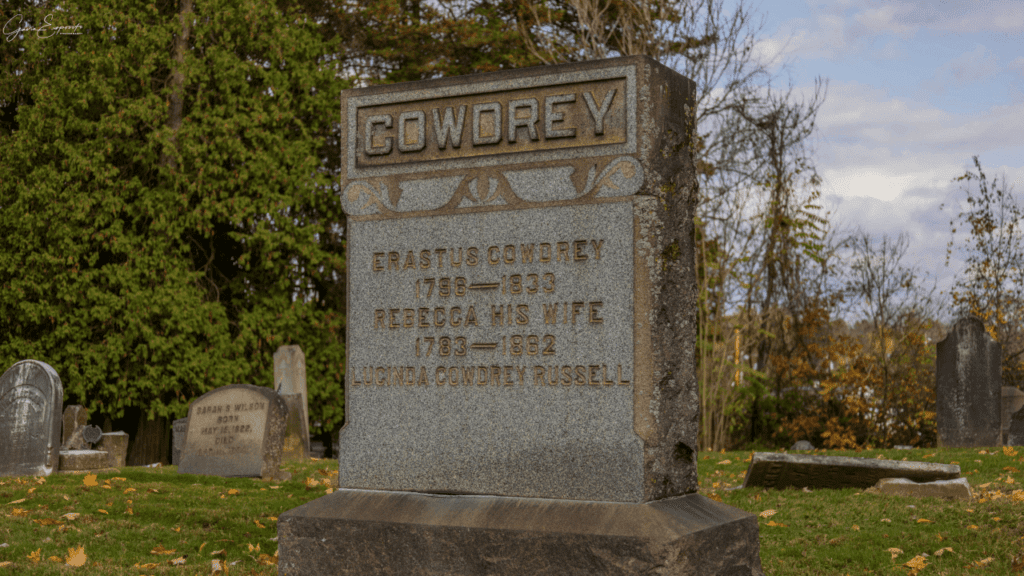Situated at the intersection of State Route 304 and Logan Way in Liberty Township, Seceders Corners Cemetery stands in a very unusual area for a cemetery.
On one side of the road, a convenience store stands, on the other, a pizzeria; and opposite from that, a Shell station. Looking past these, one will find a small cemetery abutting the gas station parking lot. Sitting in the shadow of a church, this cemetery is a remnant of Liberty Township’s historical past and holds the remains, and stories, of many of this township’s earliest settlers.

Many of the gravestones in Seceder’s Corners are made of mudstone, a material similar to sandstone. Like sandstone, it is susceptible to weathering, particularly biological growths such as lichen or fungi. These stones seem to have escaped the onslaught of growth, for now at least. (Photo by the author).
In 1803, members of the Associate Reformed Presbyterians, a group of predominantly Pennsylvanian natives of Scotch-Irish descent directed their attention to a tract of land in the southwest corner of Liberty Township, owned by James Applegate. Although perched upon a hill and quite beautiful, shortly before the transaction could be complete, a meeting took place at the home of congregation member Alexander McCleery, and a lot was offered by him which the congregation took up instead. It wouldn’t be for another 25 years that the actual deed for the cemetery was recorded on March 15th, 1828.

Although located near a gas station, pizzeria, and used car lot, once one enters this small cemetery, the cares of the modern world seem to fade away as one walks among the stones. (Photo by the author).
Seemingly plagued with issues from the beginning, in 1837, the church experienced a schism that wasn’t unique to its congregation, the Old School-New School Controversy. Initially spurring from theological differences, “old school” Presbyterians such as the Associate Reformers were not supportive of revivalism, particularly of the Congregationalist denomination, while “new school” was supportive of it. By the eve of the Civil War, the issue had become one of slavery, with northerners being naturally against it; and southerners for it, further fracturing the church. By 1869, the issue had been resolved, with the entire congregation reuniting into the Presbyterian Church of the United States. Nonetheless, the schism made its mark on Liberty, as ever since then, the small burying ground has been referred to as “Seceders Corners Cemetery.” To easily find the graves featured in this presentation, photographs and captions are included for easy identification.
James Applegate: A Founding Father of Liberty Township
The progenitor of the Applegate family in Liberty Township, James E. Applegate was born May 31st, 1765 in Monmouth, Monmouth County, New Jersey as the ninth out of twelve children of Benjamin and Rebecca (Wall) Applegate. First appearing “on the record” as a ranger in Capt. Henry Rush’s Rangers of Bedford County, Pennsylvania at the tender age of 15, he served with this regiment from 1780-1783, and for his efforts, was granted a land warrant in Providence Township, Bedford County.
Seemingly not satisfied with the land he was granted, by 1786 the Pennsylvania Septennial Census lists him as residing in Rostraver, Westmoreland County, and by 1790 with the first United States Census, he was living in Elizabeth, Allegheny County. Emigrating to Ohio in 1800, on May 27th of that year Camden Cleaveland, younger brother of Connecticut Land Company surveyor Moses Cleaveland, and namesake of Cleveland, deeds 600 acres of land to him in Liberty Township for an unrecorded sum.

As stated in the introduction, many of the stones in Secede’s Corners are made of mudstone, a material similar to sandstone. James Applegate’s is no exception and is unfortunately covered in a thick layer of lichen, however, a close look will easily confirm that this marker belongs to him. (Photo by the author).
Located four miles north of Youngstown “on the Hubbard road,” although no map exists of his land, it is quite reasonable to conclude that Applegate Road, off of Youngstown-Hubbard Road was once a part of this holding and therefore named for him. Appointed captain of the Second Regiment, Fourth Division of the Ohio Militia, he later served in the War of 1812, this time as a captain in the 27th Regiment of the U.S. Infantry raised at Warren. Applegate died on June 24th, 1820 at the age of 55, followed by his wife Mary, who died a year after him in 1821.
James Ray: In Death Did End His Days
By now, it’s probably apparent that pioneer life wasn’t for the faint-hearted. Death stalked around every corner, ready to pounce at the most opportune time, whether it be by disease, fire, fellow man; or beast. Such is the case of James Ray, who fell from a “fateal (sic) fall from his horse” on March 24th, 1824. A native of Wheatland, Westmoreland County, Pennsylvania, Ray was born there on May 21st, 1791, the son of James Ray and Hannah Horner. The family’s original name had been Rhea, but for unknown reasons upon emigrating to Ohio in 1803, the elder James changed the spelling to “Ray.”

In quaint rhyme, James Ray’s headstone tells the tale of his death falling off of a horse. A relatively common way to meet one’s end during this era. Additionally, the verse serves as a warning regarding one’s mortality: “A fateal (sic) fall from a horse/In death did end his days/Oh man prepare to meet your god /He’s just in all his ways.” (Photo by the author).
Settling first at Mantua in Portage County, according to an unpublished manuscript, the Rays were a poor family, “rather of the backwoods order.” While the elder James resided in Mantua until 1825, relocating to nearby Hiram shortly after, once of age, his children sought opportunity elsewhere, including James who struck out for Liberty some 40 miles away. It is unknown when he arrived in Liberty, but according to his marriage record dated January 14th, 1818, he had been residing there, along with his bride-to-be Mary Ann Taylor. On March 24th, 1824, James Ray, aged 34 years, suffered a fall from his horse. It is unknown how the incident occurred, but apparently, it was enough to “end his days” as the quaint couplet on his epitaph says.
John Milligan: Longing For Erin’s Strand
A son of the Emerald Isle, John Milligan was born in County Tyrone, Ireland at an unknown date in 1786. Immigrating to the United States after the birth of his fifth child, Robert in 1814, he settled at Coitsville Township in what is now Mahoning County where he would live for the remainder of his life.

Cracked and leaning, John Milligan’s obelisk might be plain, but etched into its side is a heartfelt poem about yearning for his native country. (Photo by the author).

“Far from their native land Lay far from Erin’s strand Here their bodies lie beneath the sand When the Earth delivers up its dead Without mortal fear or dread They’ll rise to meet their living Head”
Sadly, aside from this very basic information, nothing is known more of him, aside from the fact he passed from this life in 1839 at the age of 53 years. Interred beneath a cracked obelisk, an anonymous, haunting poem about yearning for Erin’s strand graces his tomb.
Sarah Jane Stewart: She Who Met An Untimely End
On September 25th, 1852, the body of Sarah Jane Stewart, a native of Coitsville Township, was found floating in the Mahoning River some miles below Youngstown, apparently drowned. Having rocks stuffed inside her skirt with the bottom tied about below the ankles, foul play was most certainly suspected. The deceased, a lifelong native of Coitsville, had been born on May 17th, 1818, to David and Agnes “Nancy” (Clark) Stewart, former residents of Adams County, Pennsylvania, and early settlers of Coitsville. Last seen alive eight days prior, around noon, she set out for Youngstown, bringing some small articles for sale.
She departed town before sundown, returning to her home in Coitsville, where she lived with her widowed mother, sister Mary, and brother-in-law, William O. Moore. At some point on her journey, Sarah was ambushed by William and violated. Moore was soon taken to Poland and questioned, but the evidence was not enough to make a case, so he was let go. Nonetheless, the local newspapers continued to speculate that he murdered her, and in March 1854, following 18 months of deliberations, William was sentenced to life in the Ohio State Penitentiary.

Decorated with a simple floral motif, Sarah Jane Stewart’s marble headstone does not indicate the horrible fate that befell her on September 25th, 1852. (Photo by the author).
He, however, would not serve his term, as in late 1861 he contracted consumption. His wife, believing his days on earth were numbered, appealed to Ohio Governor David Tod to commute his sentence, allowing him to die at home. Moore recovered enough to spend the rest of his life as a free man, passing away in 1872. His resting spot is unknown, while Sarah Jane’s at the Sceder Corners Cemetery makes no mention of the horrible fate that befell her.
Erastus Crowdery: Brother To An Early Mormon Leader
In life, it isn’t sometimes so much about what you do, but who you know; or are related to. For Erastus Crowdery, such a statement could not be truer. Born on August 13, 1796, in Wells, Rutland County, Vermont as the fourth out of seven children of William and Rebecca Fuller Cowdery, it was Erastus’ younger brother, Oliver, who served as one of the two scribes to Joseph Smith while he wrote the Book of Mormon, the foundational text of the Mormon faith. Although Oliver never resided locally, Erastrus did, migrating to Youngstown Township, Trumbull County (now Mahoning) c. 1818 from Cattaraugus County, New York.

Although related to an early Mormon figure, Erastus Cowdery did not share his brother’s beliefs, instead he was a strict adherent to Presbyteriansm, as evidenced by his membership to the Seceders Corners Church. Buried in the cemetery there beside his wife, it is likely his headstone was installed at a later date, as it is not made in the style of the 1830s. (Photo by the author).
Marrying Rebecca Pauly, a widow in Coitsville Township a year later, the two had two daughters, one of which, Sarah Jane, married into the Applegate family. Despite his brothers’ religious leanings, Erastus remained a steadfast Presbyterian, however, it is recorded that at least once he did host William McLellin, an early leader in the Mormon movement at his home in Youngstown in 1832. Passing away a year later on June 16th, 1833, Erastus was laid to rest at the Sceders Corners Cemetery and succeeded by his wife some years later in 1853.
DISCLAIMER: To preserve the headstones on this tour for the generations to come, please refrain from making grave rubbings or any other physical contact with headstones, including touching, leaning, or resting. Not only can these actions damage the stones, but destabilize them as well. As with any cemetery, be respectful to those who rest here and conduct yourself in an appropriate manner. Photography is welcomed, and encouraged: “Take nothing but photos, leave nothing but footprints.”
 ">
">










